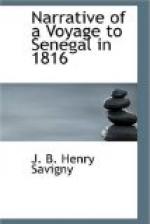Cape Verd is a peninsula about five leagues and a half long; the breadth is extremely variable. At its junction, with the continent, it is about four leagues broad; by the deep recess which the Bay of Daccard forms, it is reduced, near that village, to 600 toises, and becomes broader afterwards. This promontory, which forms the most western part of Africa, is placed, as it were, at the foot of a long hill, which represents the ancient shore of the continent. On the sea-shore, and towards the north-east, there are two hills of unequal height, which serve as a guide to mariners; and which, from the substances collected in their neighbourhood, evidently shew that they are the remains of an ancient volcano. They have received the name of Mamelles. From this place, to the western extremity of the Peninsula, the country rises towards the north-east, and terminates in a sandy beach on the opposite side.
Almost the whole north-side is composed of steep rocks, covered with large masses of oxyd of iron, or with regular columns of basalt which, for the most part, still preserve their vertical position. Their summits, which are sometimes scorified, seem to prove that they have been exposed to a great degree of heat. The soil which covers the plateau, formed by the summit of the Basaltic columns, the sides of which assume towards the Mamelles, the appearance of walls of Trapp, but already, in a great degree, changed into tuf, is arid and covered with briars. The soil of the Mamelles, like almost all that of the middle of the Peninsula, which appears to lie upon argillaceous lava, in a state of decomposition, is much better. There are even to be found, here and there, some spots that are very fertile; this is the arable land of the inhabitants. Towards the south, all resumes more or less, the appearance of a desert; and the sands, though less destitute of vegetable mould, extend from thence to the sea-shore. It is by manuring the land, with the dung of their cattle, that the Negroes raise pretty good crops of sorgho. The population of this peninsula may be estimated at ten thousand souls. It is entirely of the Yoloffe race, and shews much attachment to all the ceremonies of Islamism. The Marabous or Priests, sometimes mounted on the top of the Nests of the Termites, or on the walls surrounding their mosque, call the people several times a-day to prayer.
The social state of this little people, is a kind of republic governed by a senate, which is composed of the chiefs of most of the villages. They have taken from the Coran the idea of this form of government, as is the case with most of those, established among the nations who follow that law.
At the time of the expedition of the Medusa this senate was composed as follows:




